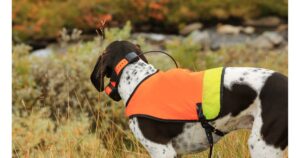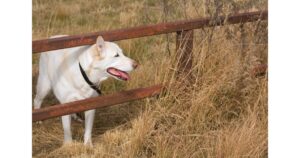Do GPS Dog fences work? Is this question bothering you as you are deciding for a good fencing system for your furry friend? Or If have any other fencing in place already and want to strengthen it further by adding a new one?The GPS fencing system’s innovative technology has developed over the years to help dog owners keep track of their beloved companions by ensuring their safety.

Key Take aways:
Table of Contents
ToggleIn this blog post, I will tell you how GPS dog fences work and what their pros and cons are. After reading the blog, you will be able to decide that Do GP’s dog fences work and are suitable for your pet or not, so let’s start.
What is a GPS Dog Fence, and How Does It Work?
A GPS dog fence is a system that uses a global position satellite to track your dog’s location. This technology uses an electronic containment system, which consists of a base unit and a receiver collar worn by the dog. When the dog collar comes into contact with the allocated boundaries of the fence, it sends an alert to the base station, which in turn warns you that the dog has left its designated area. This allows you to take action and bring your pet back home before it gets lost or has some damage. You can also track your dog via this GPS if it is lost or any other issue occurs.
Types of GPS Dog Fences
GPS Dog Fences has different styles and sizes to meet the needs of your pet. The most common is the static fence, which forms an invisible boundary around the designated area that the dog cannot cross without warning. This type offers convenience and can be set up with minimal effort.
Advanced models include wireless fences. It uses radio frequencies to emit a signal that can reach up to several hundred feet. It allows you to create many containment zones within one location and is ideal for larger properties or those who want more flexibility in setting boundaries.
Some GPS dog fences have extra features like tracking (real-time updates on your pet’s location) and remote access (i.e., the ability to adjust settings using a smartphone app).
Do GPS dog fences work? Advantages
The most common and visible advantage is the freedom of the dog. Dogs are social animals who want to roam around freely and interact with other dogs. GPS is an invisible dog fence in actuality, so most dogs feel comfortable in it.
As a dog owner, GP’s dog fencing is convenient for you as well and there are no wires attached to the dog so there is no portability issue as well. Customization of dog collars or any part of the system is quite easy. You can also adjust your fence boundaries as per your likes.
In addition, geofencing allows you to have greater monitoring, which ensures the safety of the dog in return. GPS dog fences do not damage the aesthetic appeal of your home as it remain visible as compared to wooden or concrete wall fencing.
Do GPS dog fences work? Disadvantages
The GPS dog fencing system does not work well in areas with poor signal reception. If your yard’s terrain is not equal or balanced properly, then its efficiency can decrease.
This system requires your dog to be properly trained on it which might add some additional costs for you. Stubborn dogs, large breeds, or aggressive breeds can find it challenging to get adopted into this system. We recommend you avoid GPS fencing systems for large or aggressive breeds and prefer traditional wall fencing or wrought-iron fencing.
Batteries need to be charged regularly, and their regular maintenance is necessary. Newer versions of GPS systems with additional functions will be costly, so you need to compare the pricing of all brands in advance.
Installation & Tips
The GPS dog fence installation is quite simple. Place the base unit in a prominent location in the yard. Set the boundaries carefully and as per the guidelines of the manufacturer. Note the safety precautions properly.
To make this system more effective, make sure that the chosen location has good signal reception and does not have any obstacles that could affect the signals, such as buildings or trees.
Maintenance & Troubleshooting
It’s important to check the system components (such as the base unit, collar, and boundary flags) for any damage or wear and tear. Keep the software up-to-date and replace the batteries as needed.
If you experience any technical issues, try resetting the system before contacting customer support. If all else fails, look at the user’s manual or online resources for troubleshooting advice specific to your model. If your pet is having difficulty understanding its boundaries, consider enrolling them in an obedience course to ensure they understand the importance of staying within the designated area.
Conclusion
GPS Dog Fences provide a convenient and cost-effective way to provide safety and security to your dog. With proper installation and training, you can ensure your pet’s safety. With the right setup and some training, your pet can enjoy their time outdoors without putting themselves at risk!
FAQs
1: What does the GPS dog fence cost?
The cost of a GPS dog fence can vary based on size and features but typically ranges from $600-$800. Basic models are the most affordable, while more advanced systems with extra features, such as remote access and tracking, may be pricier. Installation costs may also apply, depending on your location and the type of system you choose.
2: Can we train all dogs to use invisible fences?
Invisible fences are a great way to keep your pet safe in the outdoors, but not all dogs can use them effectively. Dogs who are more intelligent and obedient do better with invisible fencing systems.
3: Is GPS safe for dogs?
GPS is safe for dogs, though there are still some precautions to be aware of when using a GPS dog fence. It’s important to make sure that the dog collar fits properly and is not too tight around your pet’s neck. Check the battery regularly and replace it as needed.
4: Can a dog escape an invisible fence?
The answer to this question is yes; a dog can escape an invisible fence. This is because invisible fences rely on a shock collar to keep the dog within the boundaries of the fence. If the dog is determined enough, it can find a way to escape the fence. For example, if the fence is not buried deep enough, the dog can dig underneath it.









